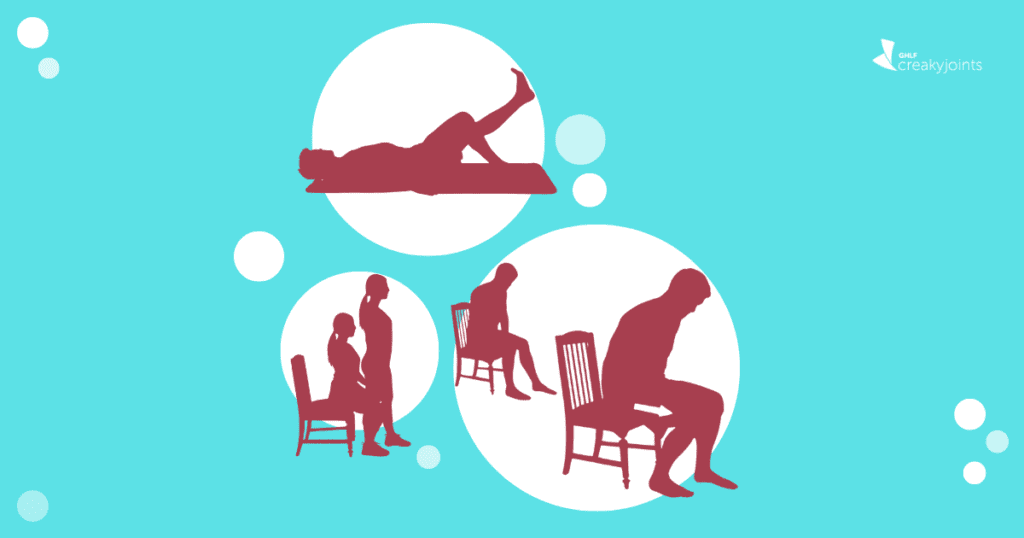

Living with knee osteoarthritis (OA) can be challenging, especially when it comes to staying active before and after surgery. It’s important to keep moving to help your joints stay flexible and your muscles strong.
Doing special exercises to strengthen and support your knee joint before surgery can help your body get ready for surgery and recover better. By following these tips — and talking regularly with your health care provider — you can stay active and manage your symptoms.
Before-Surgery Exercise Tips
Two weeks before surgery, begin incorporating 30 minutes of exercise each day. Below are specific exercises recommended by health care professionals from The Missouri Orthopaedic Institute, tailored to prepare your knees for surgery, and to support you in having a smooth recovery.
Knee Extension Stretch
This exercise is designed to help you increase the range of motion and flexibility of the knee joint, which is crucial for post-surgery recovery.
- Goal: Straighten your knee
- How to do it: Sit or lay down with your legs extended in front of you and a place a towel under your heel or ankle for support. Let your knee hang loosely, allowing it to straighten as much as possible. Let your knee do the work here. Hold for 10 minutes at a time, three times per day. Increase to 30 minutes as tolerated.
Quad Sets
Quad sets are essential for strengthening the muscles that support your knee, which is important for both pre- and post-surgical outcomes.
- Goal: Activate muscle fibers and strengthen the thigh muscle.
- How to do it: Sit up on your bed with your legs extended in front of you, straighten your knee, and tighten your thigh muscle to push the knee down against the bed. Hold for 10 seconds. Complete two sets of 15 repetitions (reps).
Straight Leg Lifts
This exercise not only strengthens the muscles but also helps improve the stability of the knee, preparing it for the demands of surgery and recovery.
- Goal: Strengthen thigh muscles.
- How to do it: Lie down on the bed. Bend the knee that will not be operated on, placing that foot on the bed. Straighten your knee to be operated on and squeeze the thigh muscle as strongly as possible and lift your leg several inches off the bed. Hold for 10 seconds and then slowly lower. Do two sets of 15 reps.
Sit-to-Stand
The sit-to-stand exercise is excellent for building strength and endurance in the leg muscles, making it easier to perform daily activities post-surgery.
- Goal: Improve muscle power and function.
- How to do it: Begin seated on a chair with armrests. Keeping your weight balanced on both feet, rise to a full standing position, then sit back down and repeat. Do two sets of 15 reps.
After-Surgery Exercise Tips
The First Weeks
- Follow a structured rehabilitation program. After your knee surgery, it’s really important to follow an outpatient therapy program. This program will usually have physical therapy exercises designed just for you, to help you get your knee strong and moving well again.
- Gradually increase activity. Post-surgery, it’s important to slowly increase your activity level so you don’t put too much strain on your new knee joint. Try to work on knee motion several times every day for the first three months after surgery, especially during the first two weeks.
3-6 Months After Surgery
- Gradually increase walking time during the first three months after your surgery.
- By about three to sixth months after surgery, you should be able to ease back into some of the activities you enjoy.
Always consult your doctor before starting any of these activities.
- Biking
- Golf
- Low-impact aerobics
- Swimming
- Tennis
- Walking
Activities to Avoid
- Contact sports
- High-impact aerobics
- Jogging/running
- Jumping sports
More Tips for a Successful Recovery
Recovering from knee surgery takes time, and it’s important to keep a positive attitude. Set small goals that you can reach and feel good about your improvements. Thinking positively can really help you get better faster and keep you motivated.
It’s also important to stay active if you have knee OA, both before and after your surgery. This helps you feel better and heal faster. Since everyone is different, make sure to adjust these tips to fit your own health needs and the way you live.
Be a More Proactive Patient with PatientSpot
PatientSpot (formerly ArthritisPower) is a patient-led, patient-centered research registry for people living with chronic conditions. You can participate in voluntary research studies about your health conditions and use the app to track your symptoms, disease activity, and medications — and share with your doctor. Learn more and sign up here.
This article was made possible with support from the Missouri Orthopaedic Institute.





